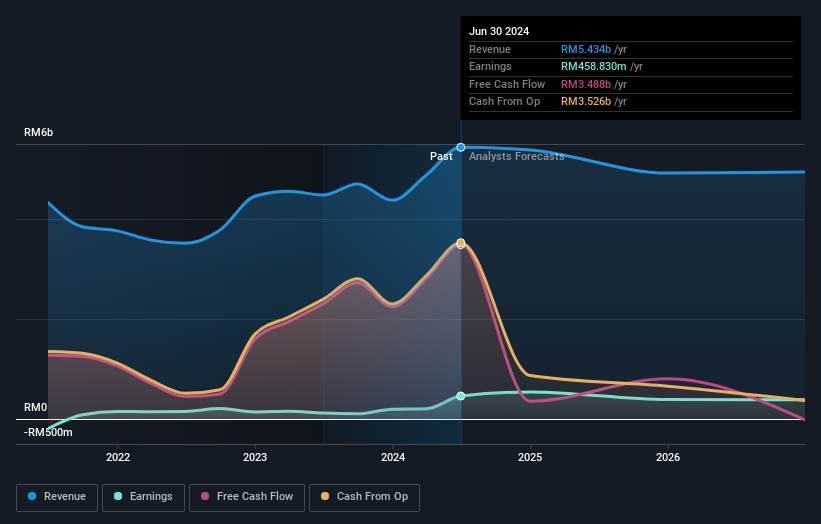Key Insights
-
Significant control over S P Setia Berhad by sovereign wealth funds implies that the general public has more power to influence management and governance-related decisions
-
The largest shareholder of the company is Permodalan Nasional Berhad with a 53% stake
To get a sense of who is truly in control of S P Setia Berhad (KLSE:SPSETIA), it is important to understand the ownership structure of the business. And the group that holds the biggest piece of the pie are sovereign wealth funds with 53% ownership. That is, the group stands to benefit the most if the stock rises (or lose the most if there is a downturn).
Following a 7.8% increase in the stock price last week, sovereign wealth funds profited the most, but institutions who own 28% stock also stood to gain from the increase.
Let’s delve deeper into each type of owner of S P Setia Berhad, beginning with the chart below.
View our latest analysis for S P Setia Berhad
What Does The Institutional Ownership Tell Us About S P Setia Berhad?
Institutions typically measure themselves against a benchmark when reporting to their own investors, so they often become more enthusiastic about a stock once it’s included in a major index. We would expect most companies to have some institutions on the register, especially if they are growing.
S P Setia Berhad already has institutions on the share registry. Indeed, they own a respectable stake in the company. This implies the analysts working for those institutions have looked at the stock and they like it. But just like anyone else, they could be wrong. When multiple institutions own a stock, there’s always a risk that they are in a ‘crowded trade’. When such a trade goes wrong, multiple parties may compete to sell stock fast. This risk is higher in a company without a history of growth. You can see S P Setia Berhad’s historic earnings and revenue below, but keep in mind there’s always more to the story.
S P Setia Berhad is not owned by hedge funds. The company’s largest shareholder is Permodalan Nasional Berhad, with ownership of 53%. With such a huge stake in the ownership, we infer that they have significant control of the future of the company. The second and third largest shareholders are Employees Provident Fund of Malaysia and Kumpulan Wang Persaraan, with an equal amount of shares to their name at 8.2%.
While studying institutional ownership for a company can add value to your research, it is also a good practice to research analyst recommendations to get a deeper understand of a stock’s expected performance. There are plenty of analysts covering the stock, so it might be worth seeing what they are forecasting, too.
Insider Ownership Of S P Setia Berhad
The definition of an insider can differ slightly between different countries, but members of the board of directors always count. The company management answer to the board and the latter should represent the interests of shareholders. Notably, sometimes top-level managers are on the board themselves.
Most consider insider ownership a positive because it can indicate the board is well aligned with other shareholders. However, on some occasions too much power is concentrated within this group.
Our data suggests that insiders own under 1% of S P Setia Berhad in their own names. It’s a big company, so even a small proportional interest can create alignment between the board and shareholders. In this case insiders own RM875k worth of shares. It is always good to see at least some insider ownership, but it might be worth checking if those insiders have been selling.
General Public Ownership
With a 19% ownership, the general public, mostly comprising of individual investors, have some degree of sway over S P Setia Berhad. This size of ownership, while considerable, may not be enough to change company policy if the decision is not in sync with other large shareholders.
Next Steps:
It’s always worth thinking about the different groups who own shares in a company. But to understand S P Setia Berhad better, we need to consider many other factors. Take risks for example – S P Setia Berhad has 4 warning signs (and 2 which make us uncomfortable) we think you should know about.
If you would prefer discover what analysts are predicting in terms of future growth, do not miss this free report on analyst forecasts.
NB: Figures in this article are calculated using data from the last twelve months, which refer to the 12-month period ending on the last date of the month the financial statement is dated. This may not be consistent with full year annual report figures.
Have feedback on this article? Concerned about the content? Get in touch with us directly. Alternatively, email editorial-team (at) simplywallst.com.
This article by Simply Wall St is general in nature. We provide commentary based on historical data and analyst forecasts only using an unbiased methodology and our articles are not intended to be financial advice. It does not constitute a recommendation to buy or sell any stock, and does not take account of your objectives, or your financial situation. We aim to bring you long-term focused analysis driven by fundamental data. Note that our analysis may not factor in the latest price-sensitive company announcements or qualitative material. Simply Wall St has no position in any stocks mentioned.
















